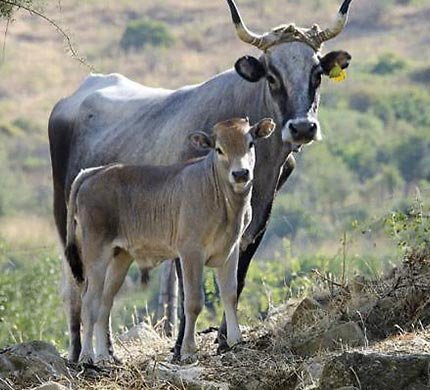Podolica
- Temperature:38.3-38.9 degrees Celsius
- Milk:800-1000 liters of milk per lactation
- Food:Pasture grasses, Forages and Hay
- Pregnancy:Approximately 9 months
- Nationality:Italy

General Information
Podolica is a breed of cattle that is native to Italy, particularly the southern regions of Calabria, Basilicata, and Puglia. The breed is named after the Podolian region of Southern Italy where it has been raised for centuries.
Podolica cattle are well-known for their hardiness and adaptability to harsh environments. They are medium-sized cattle with a distinctive gray or black coat, often with a hump on their shoulders. Podolica cattle are traditionally used for both meat and milk production, and are known for their excellent beef quality.
In terms of temperament, Podolica cattle are generally docile and calm, making them relatively easy to handle. They are also known for their intelligence and ability to adapt to changing conditions.
Where we find this cow to buy?
Finding Podolica cattle for purchase can be challenging, especially if you are located outside of Italy where the breed is primarily found.
However, there are some breeders and organizations that specialize in the breeding and promotion of Podolica cattle that may be able to help you find a source for purchasing these animals.
One such organization is the Italian Association for Podolica Cattle Breeders (Associazione Italiana Allevatori di Bovini di Razza Podolica), which maintains a registry of registered breeders and animals. They may be able to provide you with information on breeders or sales events in your area.
It is also worth contacting local agricultural organizations or livestock auctions to inquire about the availability of Podolica cattle in your region.
Additionally, online marketplaces and classified ads may offer listings for Podolica cattle for sale, though it is important to exercise caution and due diligence when purchasing animals from these sources.

How to increase milk production in Podolica
To increase milk production in Podolica cattle, there are several management practices that can be employed:
01
Ensure that the cows are fed a balanced diet that provides adequate amounts of energy, protein, minerals, and vitamins.
02
Using proper milking techniques and equipment can help to maximize milk yield and reduce stress on the cow.
03
Milking the cows more frequently (e.g. 2-3 times per day) can stimulate milk production.
04
Providing a clean, comfortable environment for the cows can reduce stress and increase milk production.
Medicine
Like all cattle breeds, Podolica cattle may require veterinary medicine to prevent and treat various health conditions. The types of medicine used for Podolica cattle are similar to those used for other cattle breeds and may include:
01
AntibioticsUsed to treat bacterial infections such as mastitis, pneumonia, and foot rot.
02
AnthelminticsUsed to treat and prevent parasitic infections such as roundworms, tapeworms, and liver flukes.
03
VaccinesUsed to prevent infectious diseases such as BVD, IBR, and leptospirosis.
04
Anti-inflammatory drugsUsed to reduce inflammation and pain associated with conditions such as arthritis or lameness.
Pregnancy
Estrus is the period when the female Podolica is receptive to mating, occurring every 21 days in non-pregnant cows.
After calving, the cow will enter a postpartum period during which she will produce milk and care for her calf.
If mating is successful, the bull’s sperm will fertilize the cow’s egg, which will then travel to the uterus.
Gestation in Podolica cattle lasts for 280-290 days, or nine months, during which the calf grows and develops inside the cow’s uterus.
The cow will go into labor and give birth to the calf without human intervention, but if there are complications, a veterinarian may need to assist.
When a female Podolica cow is in estrus, she will allow a male bull to mate with her. The bull will mount the cow and attempt to penetrate her.
Important!
It is important to note that pregnancy in Podolica cattle, as in all cattle breeds, should be carefully managed and monitored by a veterinarian to ensure the health of both the cow and calf.
Food
Podolica cattle are adaptable and well-suited to grazing on native grasses and forages found in their natural environment. Their diet should be balanced and provide adequate amounts of energy, protein, minerals, and vitamins. Here are some common food types for Podolica cattle:
Podolica cattle are well-adapted to grazing and can thrive on a variety of pasture grasses and legumes such as clover, ryegrass, and fescue.
Silage is a fermented forage made from grasses, legumes, or corn that can be used as a high-energy feed source for Podolica cattle.
High-quality hay made from grasses, legumes, or a combination of both can be used to supplement pasture grazing or as the primary forage source during the winter months.
Grain-based concentrates such as corn, barley, and soybean meal can be fed to Podolica cattle to supplement their diet with additional energy, protein, and nutrients.
Facts
Here are some interesting facts about Podolica cattle:
Podolica cattle are an ancient breed that originated in the Podolian region of Eastern Europe, which includes parts of Ukraine, Moldova, and Romania.
They are a hardy breed that is well-suited to the harsh environmental conditions of their native region, including hot summers and cold winters.
The cows are also known for their high-quality milk, which is used to make traditional cheeses such as mozzarella and ricotta.
The breed is characterized by their distinctive long, curved horns, which are used for defense against predators.
Podolica cattle are primarily raised for their meat, which is lean and flavorful, with a slightly nutty taste.
Podolica cattle have a docile temperament and are well-suited to extensive grazing systems.
They are a slow-maturing breed, with cows typically reaching maturity at around 30 months of age.
They have a strong immune system and are resistant to many common cattle diseases.